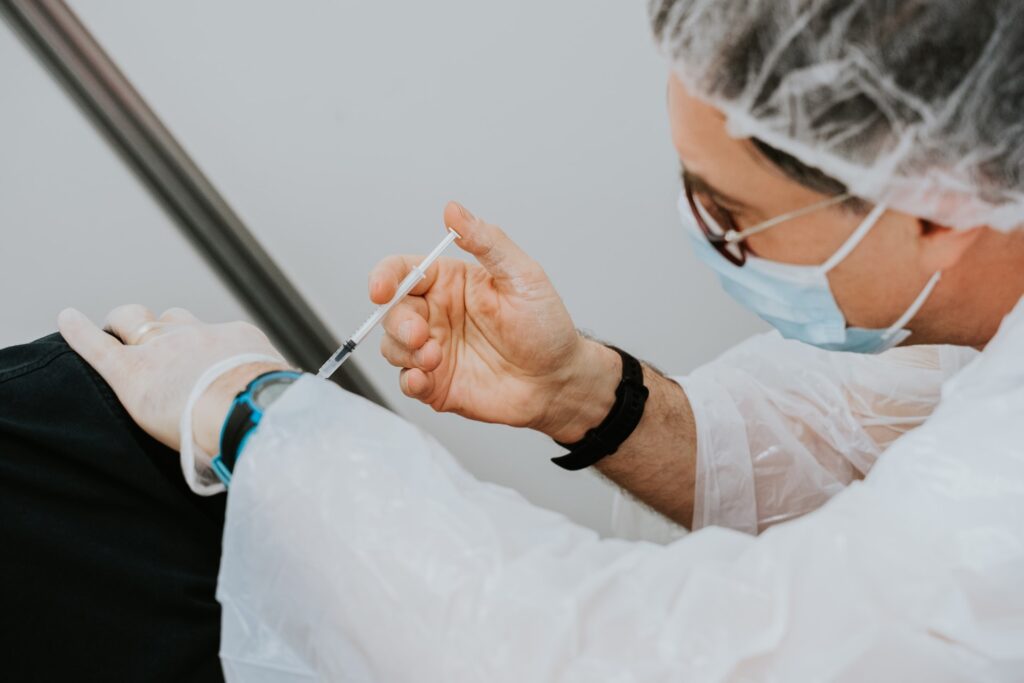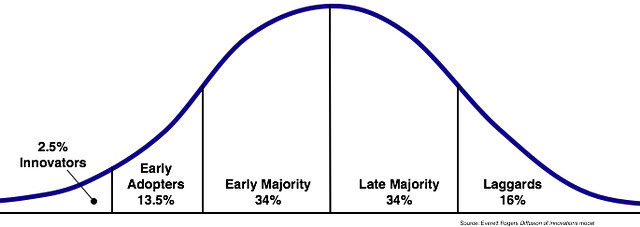So far, I haven’t felt the need to learn more about Covid or vaccines.
Maybe because I’ve felt safe.
Living in Vancouver, we had fewer lockdowns than in other parts of Canada.
Or maybe because I’m practicing selective ignorance.
Not watching the news brings your worries level to zero.
Or maybe I trust my immune system more than I should.
Whatever the reason, I’m not vaccinated.
Even if I try to stay away from the news, people like to share their knowledge with me.
So here’s the Covid-related information I’ve received so far:
- Covid kills and vaccines save lives.
- Vaccines can generate complications and kill.
- You can have a good time in Mexico. Apparently, nobody cares about Covid over there.
- Someone slapped The French President.
- Green pass is in place in Europe as well totalitarianism.
- There are trackers in vaccines. Trackers can be revealed using a magnet.
- There’s a worldwide conspiracy. Bill Gates’ name has been mentioned.
- All vaccinated people will die in the coming years.
- The world is divided into two clans: vaxxers and anti-vaxxers.
Sometimes, ignorance is bliss!
So here I am, injured in my back and having two weeks off to look into this mess.
It’s probably one of the most exhausting researches I’ve done.
I went from the bottom (virus) to the top (Bill Gates).
Is there any person above Bill Gates?
Table of Contents
1-What do Viruses want from Us?
2-How Did Humans Counterattack?
3-What Are the Different Types of Vaccines?
4-Is mRNA a Newborn?
5- Why Using an Unapproved Technology?
6-What HIV Has to Do With All This?
7-Does mRNA Interfere with Our Genes?
8- What About Adenovirus?
9-How Does Adenovirus Work?
10-What Are the Efficacy Rates of Covid-19 Vaccines?
11-Efficacy Rate: Are They Lying to Us?
12-What Are the Potential Harms of Vaccines in the Short Term?
13-What Are the Potential Harms of Not Being Vaccinated?
14-What Are the Potential Benefits and Harms of the AstraZeneca COVID-19 Vaccine (The Best Analysis)?
15-Are Covid-19 Vaccines Efficient?
16-Do the Variants Affect the Efficacy of the Vaccines?
17-How Well the Different Vaccines Work on Virus Mutations?
18-Is Herd Immunity the Solution Against COVID-19?
19-Should We Force People to Vaccinate?
20-Can We Trust Them?
21-Is It a Conspiracy?
22-How to make a decision with incomplete information?
23-Are We All in This Together?
24-What’s up, Bill?
25-Saving Lives or Making Profits?
26-Are You For or Against Vaccines?
27-Final Thoughts
1- What Do Viruses Want from Us?
Viruses like to use us as printers to make more copies of them.
As they are lacking the ability to replicate, they take advantage of our kindness when we host them.
Viruses vary in their level of lethality, contagiousness, and mutation.
They rarely have a high level of these three characteristics at the same time.
When that happens, we have something like the Spanish Flu.
It is estimated that this virus infected 500 million people and killed between 20 to 50 million victims.
The pandemic ended up in less than two years. Either the hosts developed immunity or died.
In this scenario, it seems like natural selection did all the job.
But humans haven’t been always passive.
2-How Did Humans Counterattack?
It is said that the basis of vaccination started in 1796 with the English doctor Edward Jenner.
He noticed that hanging with cows had some advantages. The milkmaids who had gotten cowpox were immune to smallpox.
They didn’t know what viruses were at that time.
The cowpox is close enough to human smallpox so that immunization to one would protect from the second.
100 years later, we used the whole killed virus strategy.
That was in France in the late 1800s. Louis Pasteur developed a vaccine for the rabies virus.
And since then, we have developed a whole bunch of ways of making vaccines.

As you can see, we did a bunch of atrocities to the poor pathogen.
We killed it, maintained it half-alive, stripped away its clothes, or wrapped it in a new virus.
But why we didn’t stick to the first strategy—the whole killed virus?
3-What Are the Different Types of Vaccines?

In this article, I won’t expand on the Chinese or Russian vaccines.
At the moment I’m writing, they are not available in Vancouver where I’m living. Plus, in case I go to Europe visiting my family, they are not accepted.
So I’ll focus on these four:
-mRNA Vaccines: Pfizer-BioNTech / Moderna
-Viral Vector-Based Vaccines: AstraZeneca / Janssen (Johnson & Johnson)
As you can see, in my situation, I’m only left with 2 types of vaccines instead of four.
The two choices that I don’t have are among the most tested and used technologies.
At this point, my choice is between new technology and a used/tested technology.
4-Is mRNA Technology a Newborn?
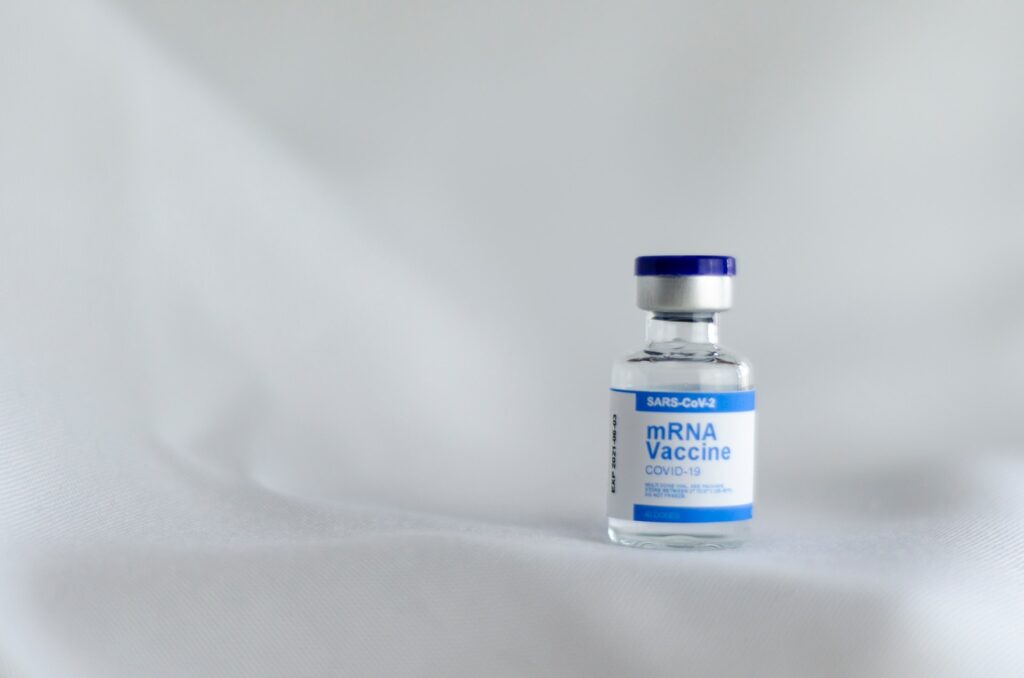
In How mRNA Technology Could Change the World, Derek Thompson wrote:
“The dream of mRNA persevered in part because its core principle was tantalizingly simple, even beautiful: The world’s most powerful drug factory might be inside all of us.”
[The Atlantic]
Persevering here refers to the decades that mRNA technology went through.
mRNA technology— messenger ribonucleic acid—sounds like web programming, but for the body.
You enter a code that tells your cells which proteins to make.
Sound simple, right? It just took 40 years for the mRNA to become a superstar (and a multibillion-dollar idea).
The Hungarian-born scientist Katalin Kariko is behind the mRNA discovery.
She started working on it in the seventies.
In the 90s, she spent her time collecting rejections. No one wanted to fund or support this idea.
It was attractive on paper. But getting the body to not immediately rejecting the mRNA, that was another thing.
In early 2000, she finally found a way to get the mRNA under the radar of our body’s defenses.
Some people saw the potential of this discovery.
In the US, Moderna is born. In Germany, it’s BioNTech, founded by the couple Ugur Sahin and Özlem Türeci.
5-Why Using an Unapproved Technology?
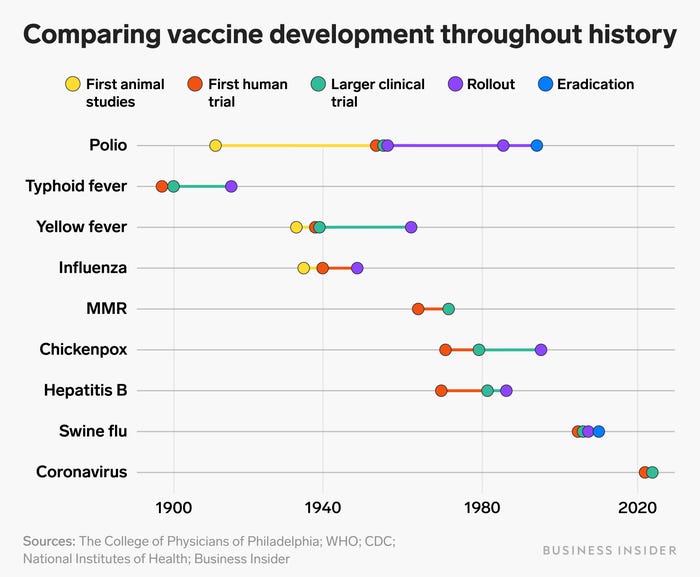
This is a question I asked myself: Why using new technology that has never been approved before the pandemic instead of an old one that has been tried and tested?
The answer I found is speed.
If you look at the graph above, it can take years for a vaccine to be licensed.
It took for example 12 years for the flu vaccine to be approved.
Meanwhile, Moderna designed its vaccine in just two days and started the trials before I had even heard of the coronavirus!
Both Pfizer and Moderna were working on other projects from flu to cancer.
mRNA allowed them to shift immediately their researches toward SARS-CoV-2.
All they needed is the genetic sequence of the coronavirus to make the vaccine. No need for the step ‘cultivating a virus in the lab’.
Philip Dormitzer, who leads Pfizer’s viral-vaccines research and development programs, put it this way:
“It was really a case of our researchers swapping the flu protein for the coronavirus spike protein. It turned out that it wasn’t that big a leap.”
I get it. mRNA can be edited very quickly. And that’s why some people talk about ‘an overnight vaccine’.
6-What HIV Has to Do With All This?
Instead of finding more answers, I’m finding more questions:
Why they could develop the Covid vaccine overnight but not the HIV vaccine that they’ve been working on for years?
So here’s what I found.
HIV is not some dumb virus that you can easily kill.
The two-fold strategy of the Human Immunodeficiency Virus is this.
First, HIV is continuously mutating. Not from year to year, but as soon as you get infected.
Second, HIV grows up in our T cells. These are important white blood cells playing a central role in our immune system.
Smart HIV. It paralyzes our defense system and at the same time, it keeps mutating.
The combination of the two factors leaves no chance for the body to catch up.
I also found a paper by Jeffrey E. Harris, an economist at MIT, who argued that the failure to develop an HIV vaccine laid the groundwork for SARS-COV-2 vaccines.
He wrote:
“Nearly 90 percent of COVID-19 vaccines that made it to clinical trials used technology that could be traced back to prototypes tested in HIV vaccine trials.”
7-Does mRNA Interfere with Our Genes?
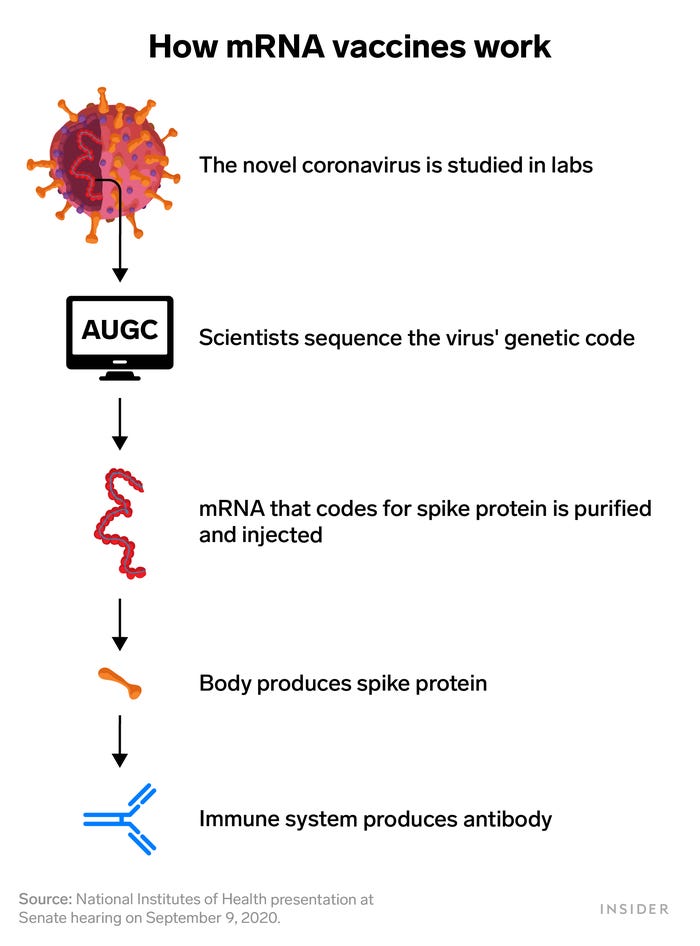
mRNA is also associated by some with turning us into a genetically modified humans.
It crossed my mind, for a second, the perspective of turning into an X-Men with some cool superpowers.
What I read is less exciting.
The four vaccines strategies are using the same process.
In one form or another, they are injecting the viral protein then the body does the rest of the work.
It seems like it’s the term ‘genetic strategy’ that confuses people.
I can understand this feeling.
When I hear ‘herd immunology’, I visualize crazy scientists ready to slaughter a group of cattle.
Anyway, it seems like mRNA can’t alter our DNA for multiple reasons.
To get to our DNA, mRNA needs to pass the nuclear membrane. But it doesn’t have the password so it can’t.
And even if it had access, it needs to be converted to DNA before blending with ours. But it’s not equipped for that.
8-What About Adenovirus?
I feel I have enough information about mRNA to impress friends and colleagues.
Adenovirus vaccine is the same technology used by AstraZeneca or Janssen.
The reason we came to develop this kind of technology is efficiency.
The classical approaches of using an inactivated virus or live-attenuated virus have not been successful for all viruses.
It’s not the first time we use the Adenovirus vaccine—also called the Viral Vector vaccine.
Dengvaxia, Sanofi’s Dengue vaccine, is based on this technology.
It has been licensed for human use by The Food and Drug Administration (FDA) under significant restrictions.
There’s a controversy about this vaccine related to what happened to vaccinated schoolchildren in the Philippines.
Viral vector vaccine has also been used for the Ebola virus.
The rVSV-ZEBOV was approved for medical use in the European Union and the United States in 2019.
I don’t why people worry more about mRNA vaccines than vector vaccines.
The adenovirus is a DNA virus.
It means that it gets not just into a cell but into the cell’s nucleus. However, it doesn’t blend with the genome.
9-How Does Adenovirus Work?
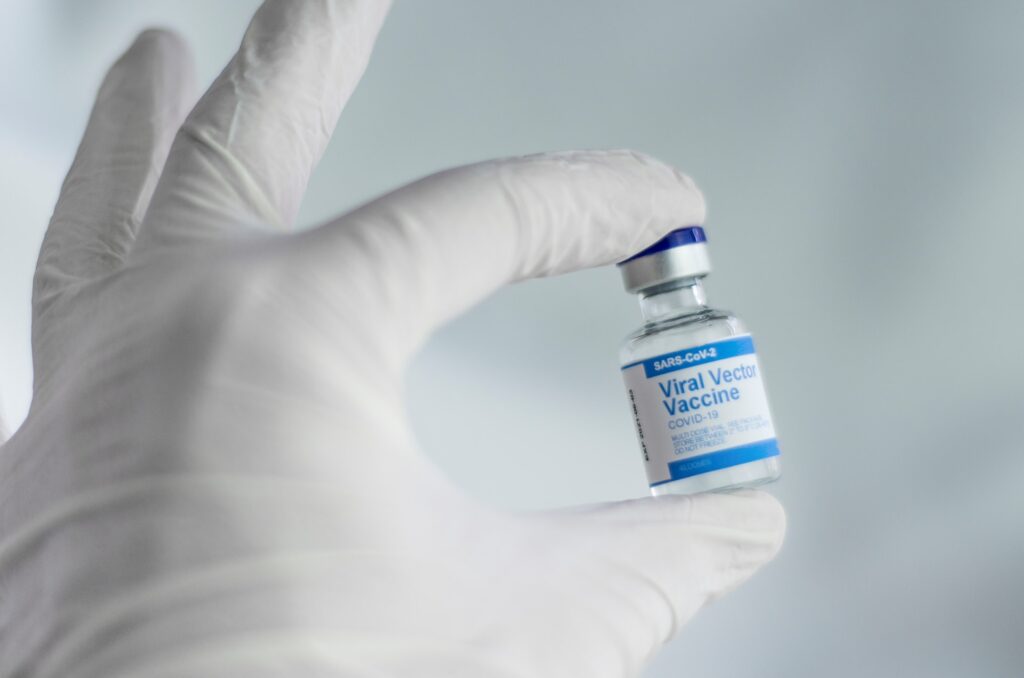
Viral vector-based vaccine is a well-established technology.
Its main benefit is to provoke a strong immune response.
They take the genetic instructions for building the virus protein (DNA), then they put in a gentler virus (adenovirus), and they deliver the whole to the body.
Adenoviruses are common viruses that can cause colds or flu-like symptoms.
For example, AstraZeneca uses a modified version of a chimpanzee adenovirus.
Should we worry about being transformed into Chubeka?
Technically not. The adenovirus is disabled before it’s injected, so it won’t replicate inside the body.
In our case, we’re looking at getting the instructions for making the spike protein of SARS-CoV-2 into the cell.
When that happens, the production of the spike protein starts, which leads the immune system to produce antibodies to neutralize it.
The COVID-19 viral vector vaccines in use are non-replicating viral vectors. It means the vector (adenovirus) is engineered so it can’t make copies of itself.
So far so good?
Let’s see now the difference between the four vaccines I mentioned: Pfizer, Moderna, AstraZeneca, and J&J.
10-What Are the Efficacy Rates of Covid-19 Vaccines?
You’ve probably already heard about efficacy rates of the different Covid-19 vaccines:
- Pfizer: 95%
- Moderna: 94%
- AstraZeneca: 67%
- Johnson & Johnson: 66%
If you look only at these numbers, you’ll normally pick Pfizer and Moderna as the best vaccines.
But these numbers only say what happened during the first clinical trials. It’s not a guarantee that we’ll have the same results in the real world.
And what happened during the vaccine trials is that each company designed its own. That’s why we can’t compare them.
The timing was different.
If you do your trials when the number of daily Covid-19 cases is low, it’s normal that the results will be better.
It seems like J&J had harder conditions.
Not only the case rate was going up when they did the testing, but also the main virus was the variant.
Also, if we take a look at demographic information, we find differences as well.
People of color were underrepresented in the clinical trials.
J&J had 62% white. The other vaccines trials had between 79% to 90%.
But, as a rule of thumb, it is said that any vaccine that has an efficacy rate above 50% is good.
The goal is not really to have zero infection.
The goal is to get us out of the zone where we can die, have a serious disease, or be hospitalized.
Anyway, if you want to vaccinate the whole globe, you can’t be that peaky. Right?
11-Efficacy Rate: Are They Lying to Us?
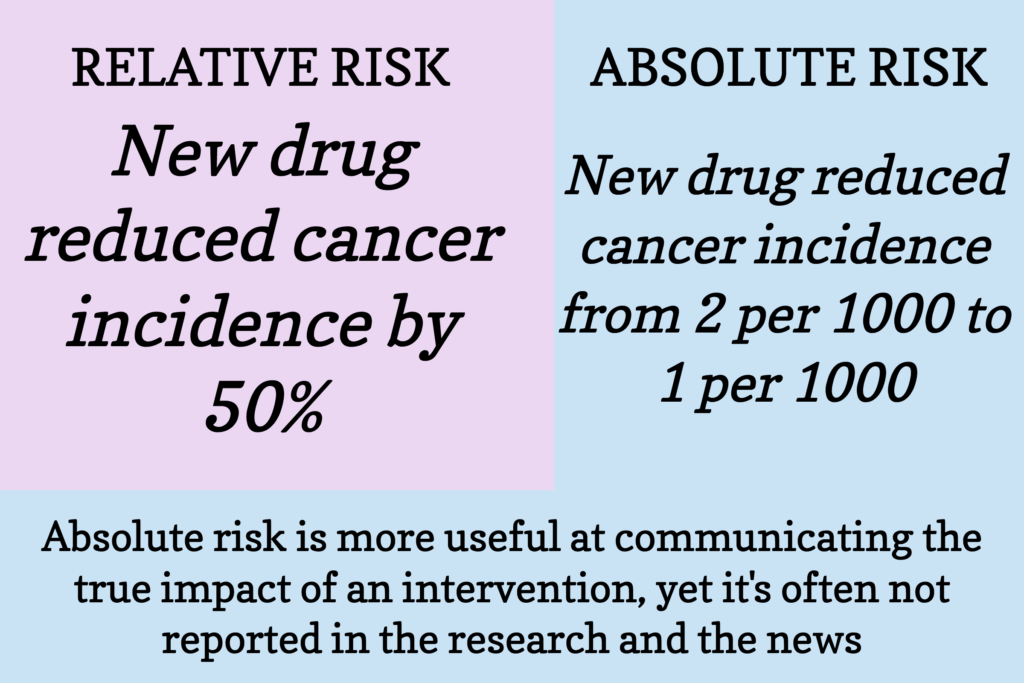
The vaccine efficacy is also called relative risk reduction (RRR). This is the number you see everywhere.
But there’s another number we communicate less about. It’s the Absolute Risk Reduction (ARR).
The Lancet mentioned the ARR for the different vaccines: Astra Zeneca 1.3%, Moderna 1.2%, J&J 1.2%, and Pfizer 0.84%.
As you can see, the ARR is much lower than the RRR. Also, Pfizer who came first in efficacy rate is now last.
Instead of giving a definition, I’ll just give an example.
Let’s take the previous numbers given in the video.
Pfizer had a trial with 43000 participants. We split them into two halves.
21500 had a placebo. 21500 were vaccinated. And we just let them be and see what happens.
In the placebo group, 162 were infected. 8 in the vaccinated group.
ARR= (162-8)/21500=0.71%
RRR= (162-8)/162=95%
The RRR is more appealing. However, without ARR, we can’t know the true impact of a vaccine. gives you the context of the trials.
In Studying Studies: Part I – relative risk vs. absolute risk, Peter Attia wrote:
“The way most studies interpret and report the results is through relative risk reduction (or increase). Why? Frankly, because it’s more headline-worthy, we suppose.”
To have a better idea about the efficiency of a vaccine, we need both numbers.
By communicating only RRR, we increase people’s suspicions about the efficiency of a vaccine.
12-What Are the Potential Harms of Vaccines in the Short Term?
I’ve never heard about something similar in our history.
People are more afraid of the cure than the disease itself.
Anyway, at the moment I’m writing, here’s the data coming from the World Health Organization (WHO):
“Globally, as of 10:37 am CEST, 9 August 2021, there have been 202,296,216 confirmed cases of COVID-19, including 4,288,134 deaths, reported to WHO. As of 5 August 2021, a total of 3,984,596,440 vaccine doses have been administered.”
It’s too early to talk about the potential harm of vaccines in the long term. The Covid-19 vaccines are new and we can only speculate about the future.
In Peter Attia’s podcast, Paul Offit– pediatrician serving on the FDA committee evaluating COVID-19 vaccines– said that if no serious adverse events show up in the two months following the vaccination, it’s all good. But nothing is 100% sure.
In the short run, it is safe to say that we vaccinated enough people to know that the risk of serious adverse events is low.
However, It doesn’t mean that the vaccines are risk-free.
The J&J and AstraZeneca vaccines have been associated with very rare but severe blood clots.
People with severe allergies may be more likely to get an anaphylactic shock from the mRNA-based two-dose vaccines. Pfizer and Moderna can also cause myocarditis and pericarditis among male adolescents and young adults.
They are also deaths reported after the COVID-19 vaccinations. But I didn’t find any report that says it’s 100% caused by the vaccines.
I didn’t consider as harm the common side effects from COVID-19 vaccines–injection site pain, fatigue, headache, muscle pain, fever, joint pain, chills, nausea, or swelling.
13-What Are the Potential Harms of Not Being Vaccinated?
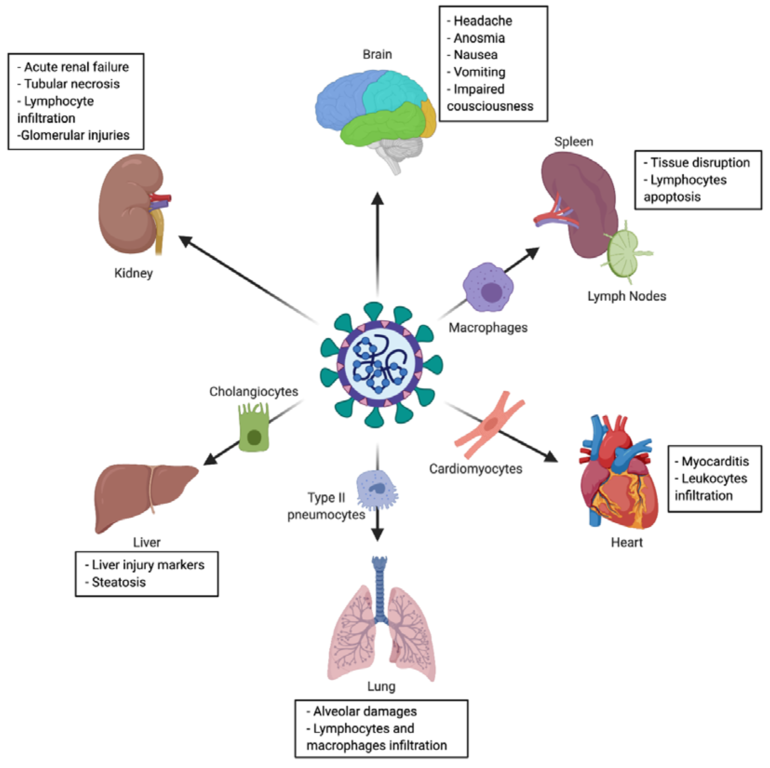
The world population is estimated at 7,794,798,739. The number of deaths is estimated at 4,293,591 (9 Aug 2021). That’s 0.55% of the world population.
Most people who had COVID-19 recovered quickly.
The lungs are the organs most affected by COVID-19. The virus can also cause chronic damage to the cardiovascular system, the kidneys, and other organs.
At a greater risk of catching the COVID-19 are the ones in contact with a large number of people.
At risk of severe harm or deaths are:
-Older adult (60 years old and above)
-People with chronic medical conditions: lung, heart, liver, or kidney disease, high blood pressure, diabetes, dementia, stroke.
-People with a compromised immune system (ex: cancer)
-Obesity
14-What Are the Potential Benefits and Harms of the AstraZeneca COVID-19 Vaccine (The Best Analysis)?
Here’s another way to look at benefits and harms.
Instead of comparing the risk of getting Covid to the risk of getting vaccinated, Winton Centre published a document comparing the potential blood-clot risk of the AstraZeneca vaccine to its actual benefit.
It’s the smartest way I’ve read so far on weighing benefits and risks.
It shows why making a decision about vaccines is a complex process.
The risk/benefit ratio varies between different people.
The level of exposure, age category, or even gender affects the ratio considerably.
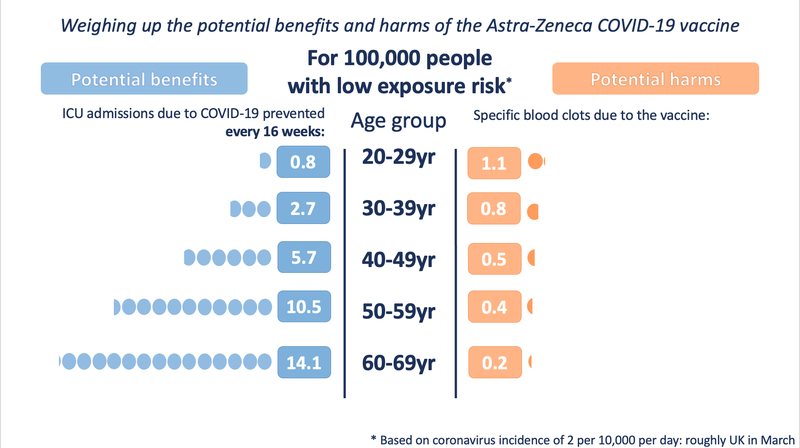
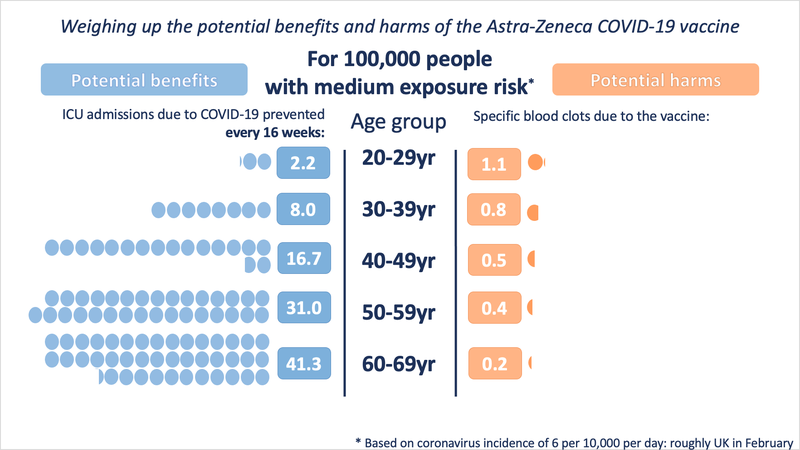
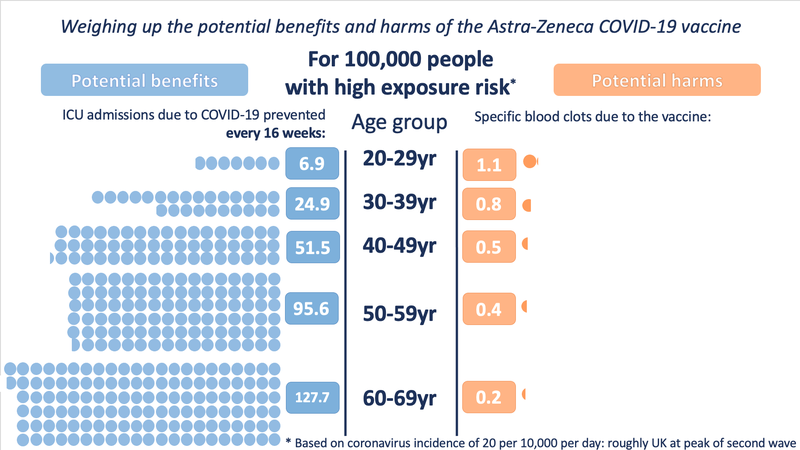
I used the article dating from 7th April 2021. It concerns the UK.
They updated recently using data of the 6th May 2021.
Except for a slight increase in the risk, there’s no difference.
They also added analysis in a very low exposure risk situation.
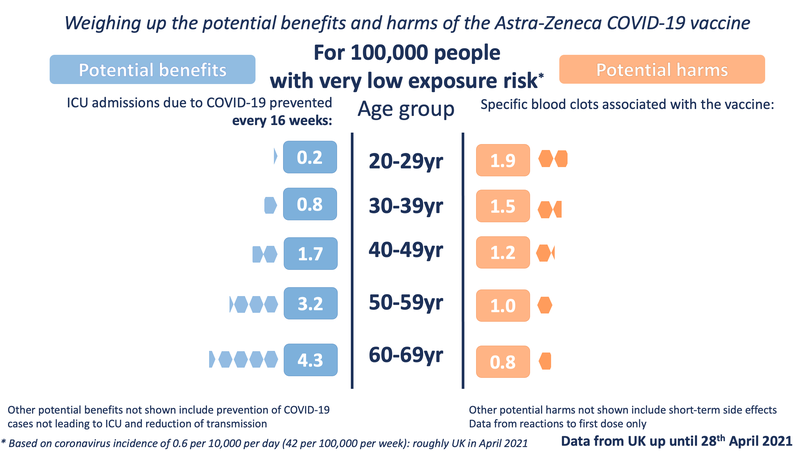
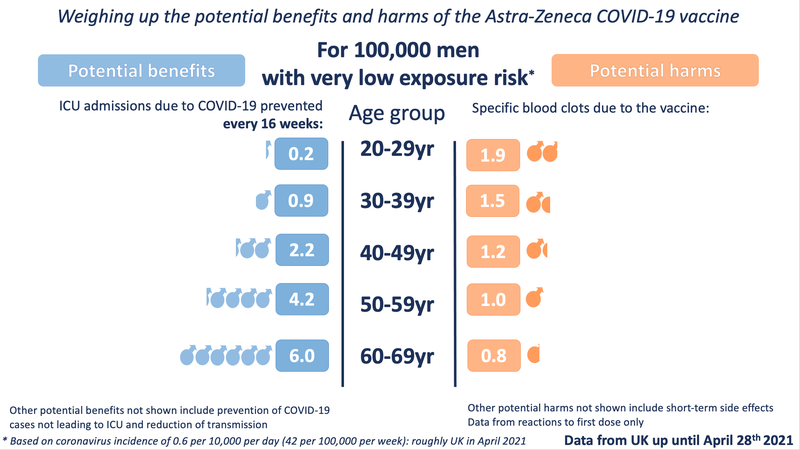
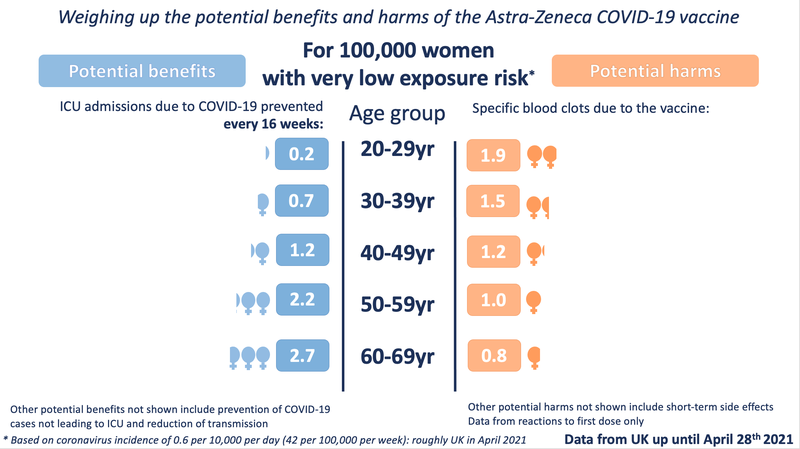
As we can see, risks and benefits depend more on personal situations than the vaccine itself.
The risk of the vaccine doesn’t vary that much.
But what makes the risk high or low is mostly the level of exposure and age group.
I won’t be surprised if we find similar ratios for the rest of the Covid-19 vaccines.
15-Are Covid-19 Vaccines Efficient?
In The Safety of COVID-19 Vaccinations–We Should Rethink the Policy, the authors argue that vaccination is lacking clear benefits.
The article has been retracted but the authors didn’t agree.
Walach and his team used a large Israeli field study and crossed it with European data.
What they found is that the benefits of vaccination don’t outweigh the risks.
To save 1 person from death due to COVID-19, we need to vaccinate between 9000 and 50000 persons.
At the same time, they found that vaccinating 100000 persons lead to 16 serious side effects and 4 deaths.
Their conclusion is: “For three deaths prevented by vaccination we have to accept two inflicted by vaccination.”
This study could be completed with the serious adverse events prevented by vaccination.
In Our World in Data, I pull out some charts I don’t understand.
The first chart shows how many people are fully or partly vaccinated in different countries.
What I expect is that the countries that are vaccinated the most will have fewer COVID-19 cases. And I expect the opposite for the countries that vaccinated the less.
But I don’t find this tendency in certain countries.
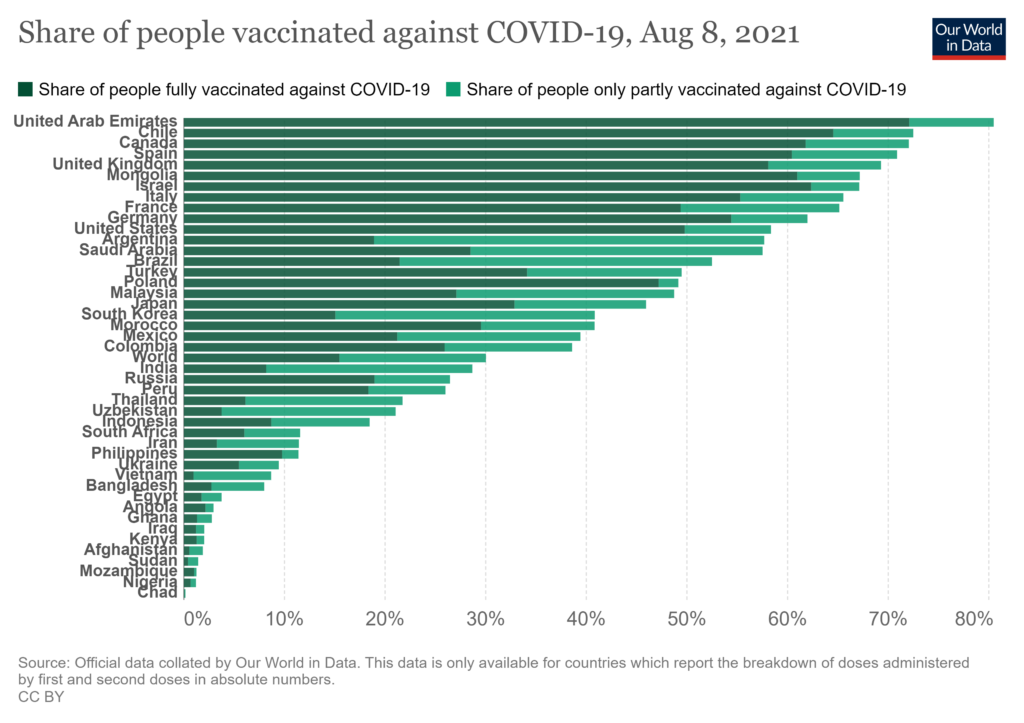
I compared France to Germany, Chile to Paraguay, Mongolia to India, and Morocco to South Africa.
For every two countries, I compared the numbers of daily new COVID-19 and the numbers of COVID-19 vaccine doses administered per 100 people.
France and Germany have a similar number of doses, but the cases go up much higher in France than in Germany.
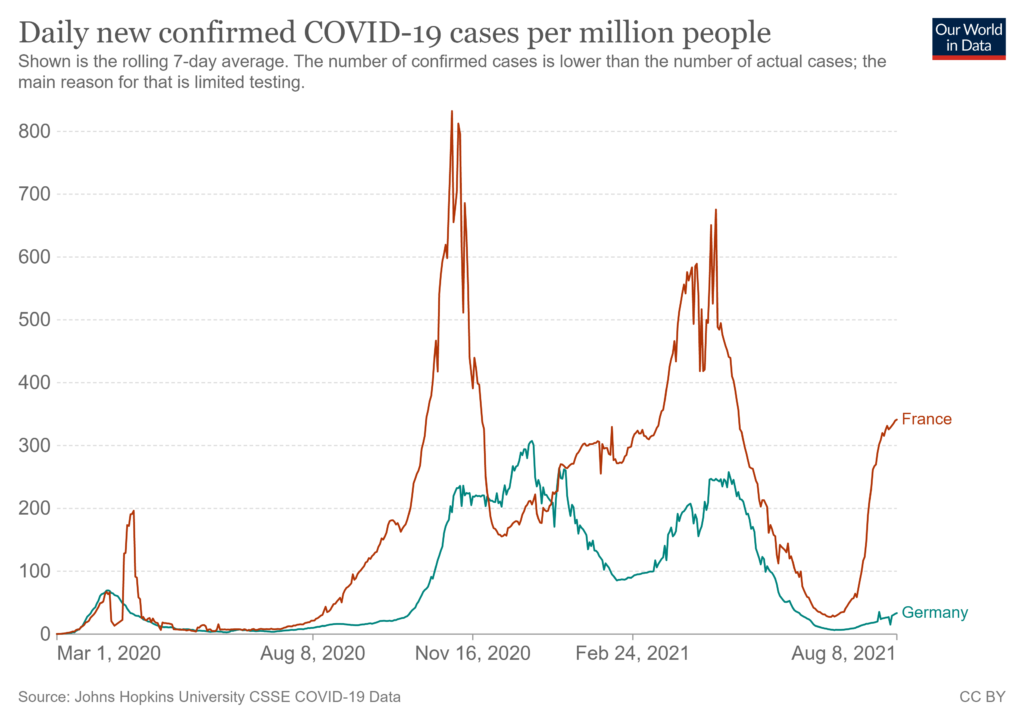
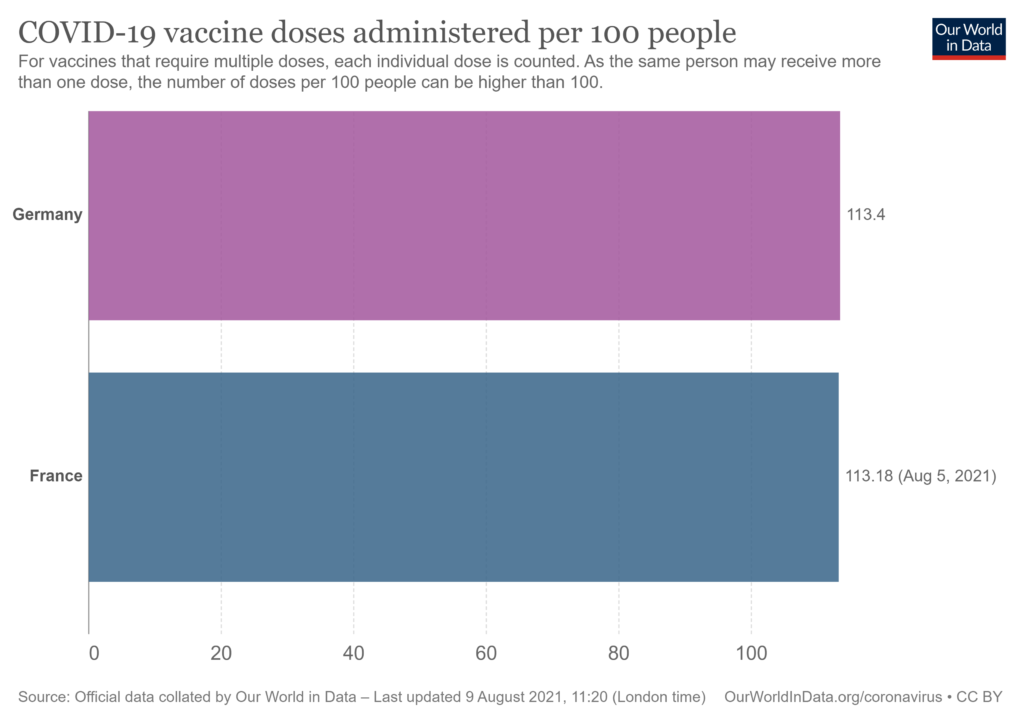
Chile is one of the top vaccinators in the world. But the number of new COVID-19 cases is similar to Paraguay where the vaccination rate was much lower.
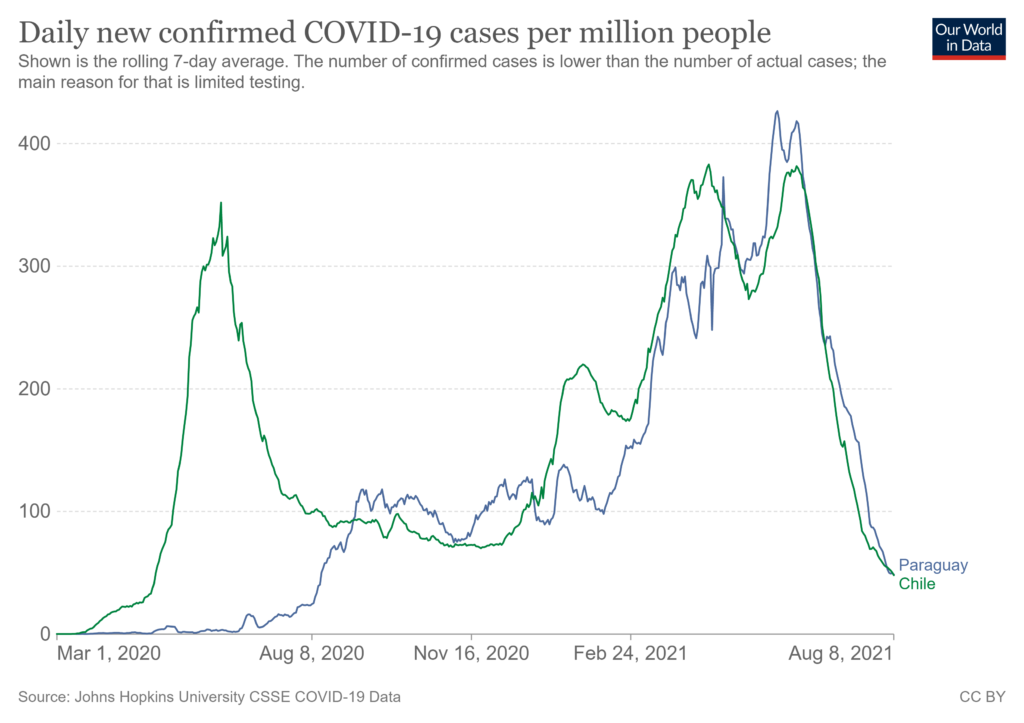
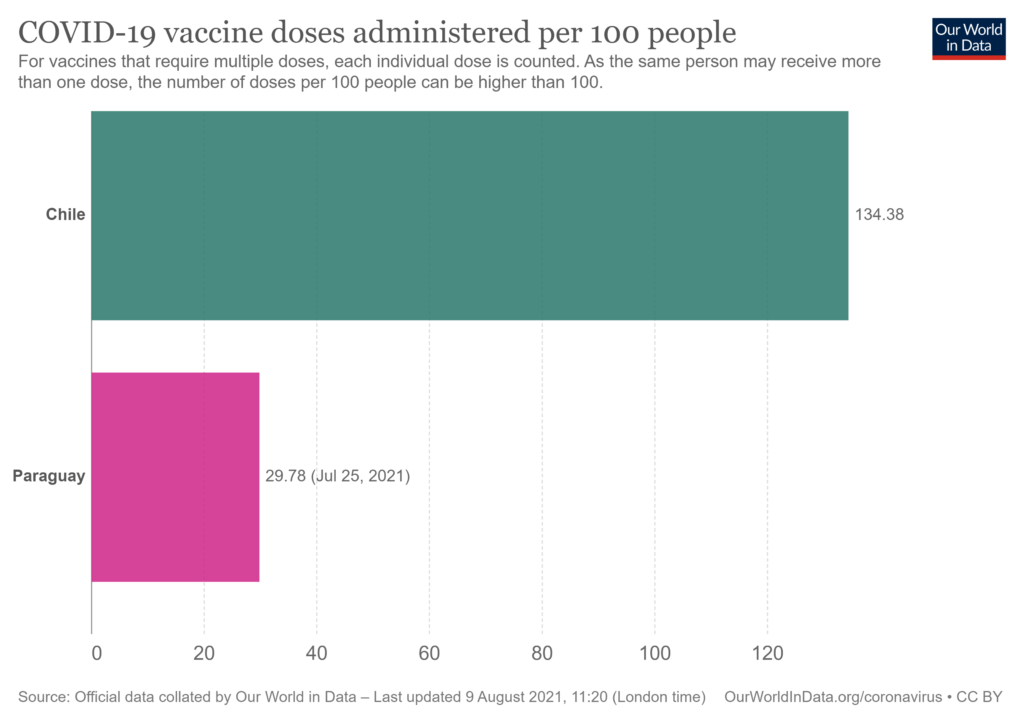
Mongolia vaccinated much more than France or Germany. But the cases went much higher than for India who vaccinated less.

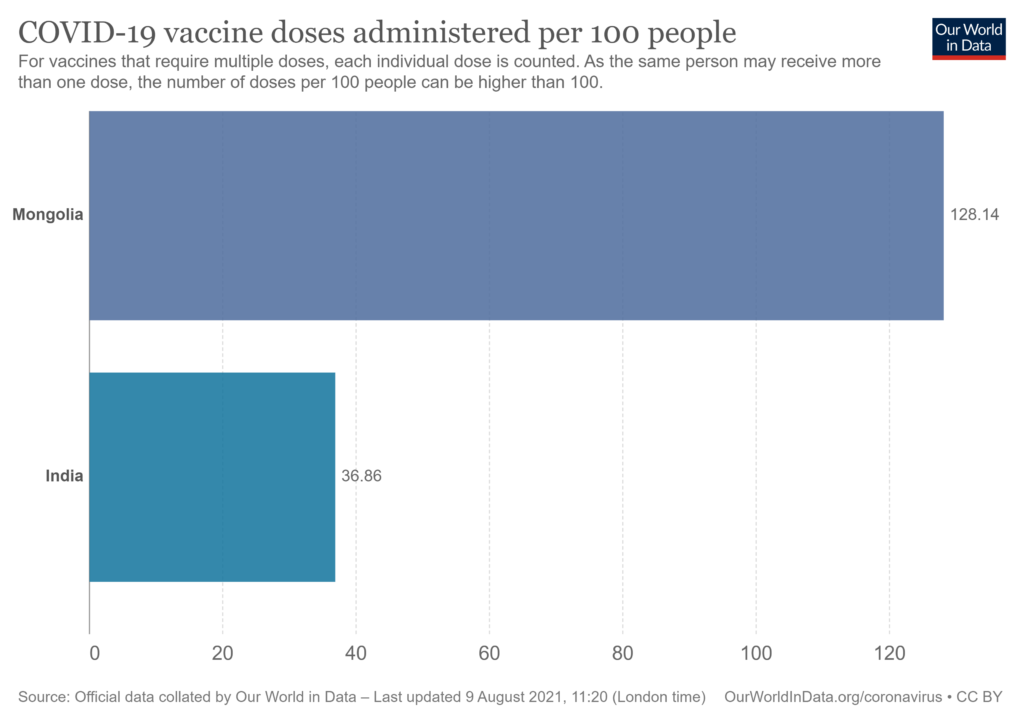
We find something similar in comparing Morocco to South Africa.
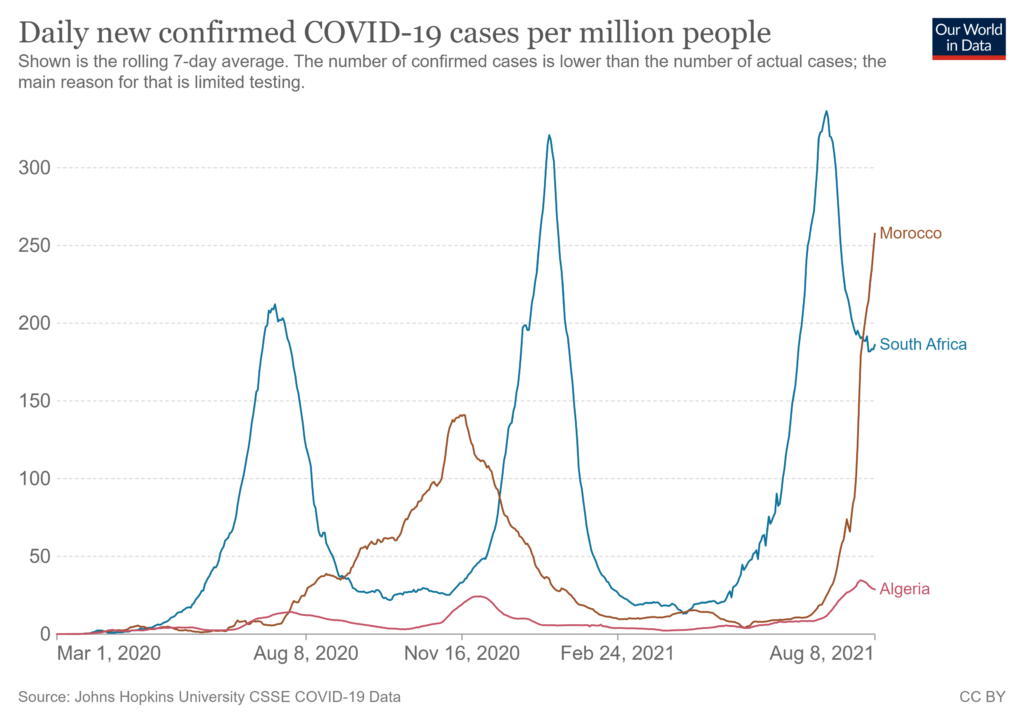
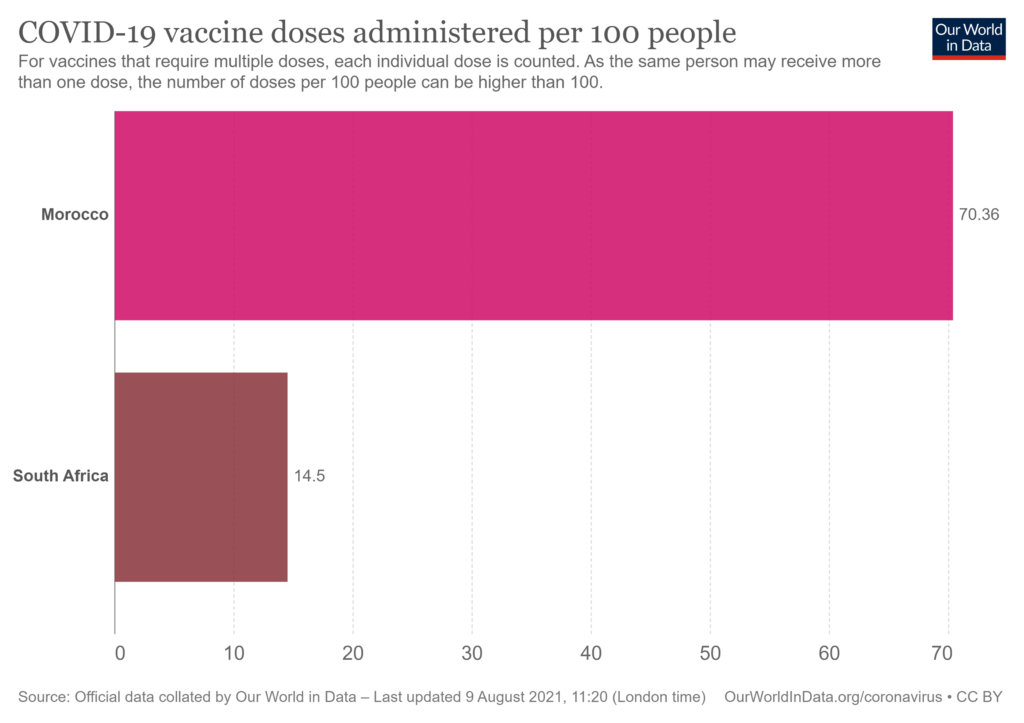
As I don’t know what to think of these data, I’ll move on to variants and herd immunity.
16-Do the Variants Affect the Efficacy of the Vaccines?
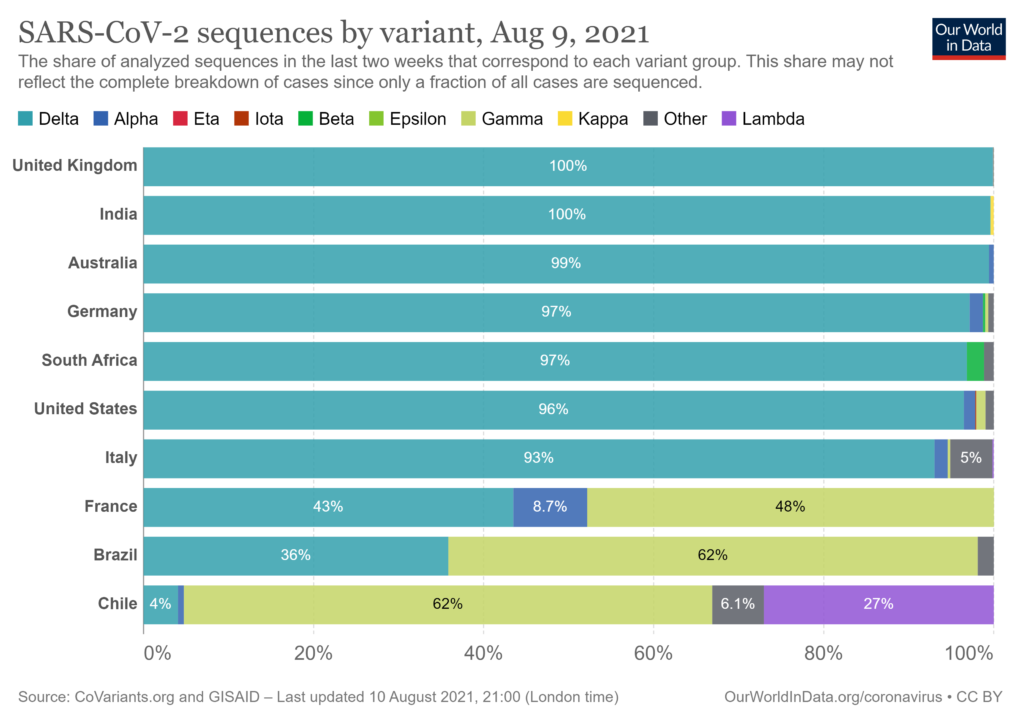
Concerning the variants, I didn’t find the data about the different countries mentioned above.
It would be interesting to know the increase of COVID-19 and compare it to the spread of the variants.
Anyway, we can’t expect the mRNA and Adenovirus vaccines to have high efficacy against the variants.
We take a part of the virus to develop those vaccines. Our immunity is less ready to face variants than if we develop the vaccine from the whole virus.
The variants not only affect the efficacy of a vaccine but can also make us more receptive to the virus.
Young healthy adults that didn’t have to worry about the original strain might start worrying…
17-How Well the Different Vaccines Work on Virus Mutations?
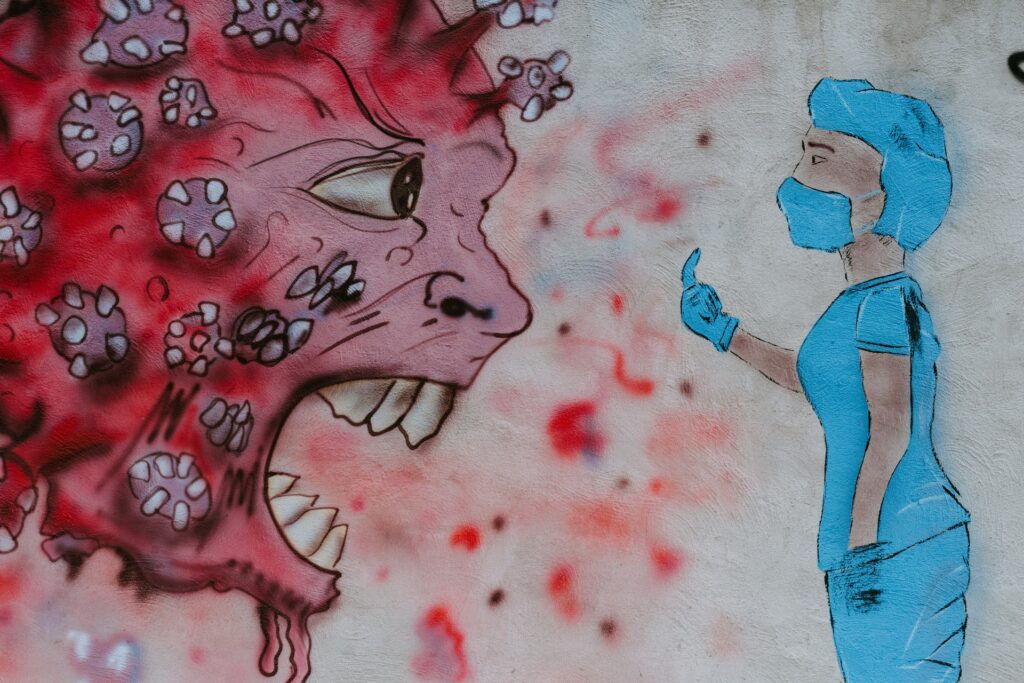
The variants are counterattacking.
They are more transmissible and seem to care less about the high efficacy rate of the vaccines.
The Lancet published a paper called Pandemic moves and countermoves: vaccines and viral variants.
It shows that even if AstraZeneca kept its efficacy against the UK variant, it is less compared to the efficacy against the original strain.
Another study showed that the Pfizer vaccine efficacy went from 96% to 84% over six months.
We don’t know yet if the vaccine is losing efficacy over time or the variants make it look less effective.
Overall, all vaccines lost some efficacy with the appearance of variants.
However, it is said that the vaccines are still efficient to prevent deaths, severe illnesses, and hospitalizations.
An article in Yale Medicine compares the different vaccines including how well they work against viruses.
In summary, the efficacy of the vaccines is still good, but it’s changing depending on the variants…and the different studies that are published.
18-Is Herd Immunity the Solution Against COVID-19?
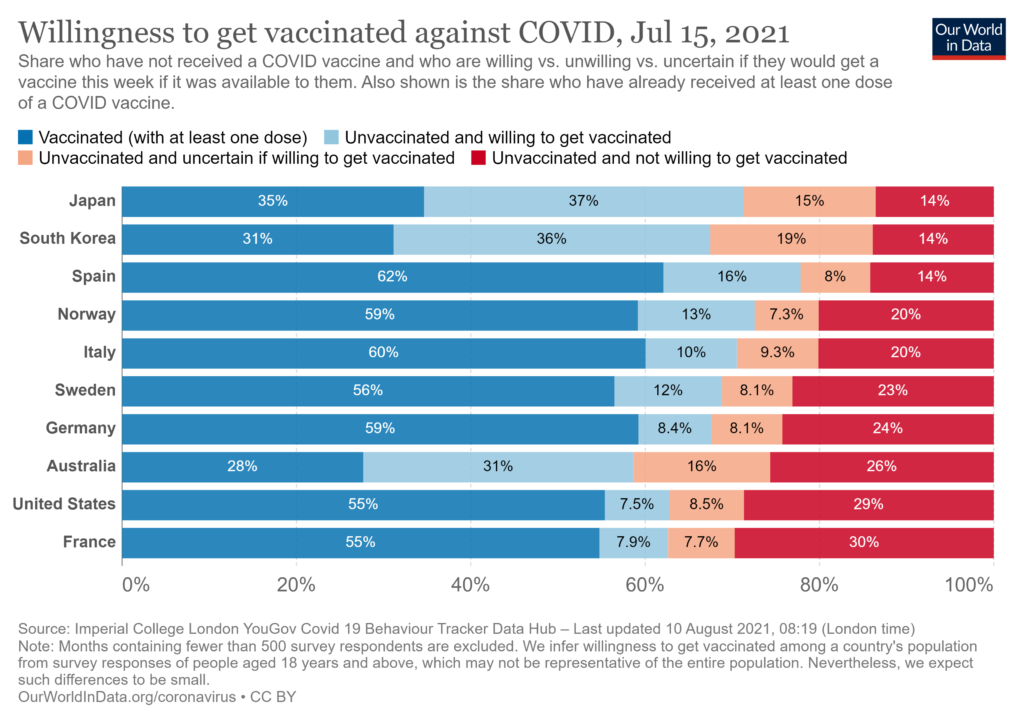
Herd Immunity. What is this new term that enriches my vocabulary?
I hope is not something like “flattening the curve” that we use to hear at beginning of the pandemic!
The herd immunity stipulates that if we vaccinate a large portion of a population, it will be difficult for a virus to find a host.
But like any theory, the herd immunity concept simplifies the complexity of reality.
For example, it has the assumption that people who survive an infection will become immune.
But in the real world, cases of reinfections have been reported. It’s a small portion of the population, but it happens.,
The same with vaccines. The variants can bypass the immunity created by the vaccines.
If the immune becomes infected again, we’ll never reach herd immunity.
Also, there’s the problem of vaccine hesitancy.
In 2019, The World Health Organization listed “vaccine hesitancy” among the top 10 global health threats, along with HIV, Ebola, air pollution, and climate change.
Some people won’t vaccinate. They might be skeptical about the benefits or they might have personal or moral reasons for not doing so.
Another problem facing the achievement of herd immunity is the uneven distribution of vaccines.
Some countries have a high rate of vaccination while others have barely started.
Last but not least, seeking herd immunity increases the risk for a portion of the population to have serious adverse events or even die from the vaccines.
19-Should We Force People to Vaccinate?
If we consider the available vaccines like any other new technology, it is likely they’ll follow the technology adoption lifecycle.
We can object that vaccines have been around for a while.
Yes. But the novelty (or the perception of novelty) comes from the way we manufacture them.
The cycle of adoption over time goes from the extremely enthusiastic to the extremely skeptical.
The late majority adopts an idea when they see it working for others.
For them, it’s just a matter of time before they adopt the new technology. All they need is to witness the benefits.
But for the laggards, no number of arguments can change their mind. They won’t adopt a new technology until they have no choice.
The problem with forcing people to vaccinate is it reinforces their antivaccine sentiment.
Europe adopted an indirect approach. They let people choose but at the same time, they make the social life of unvaccinated people more complicated.
I’m not sure if the green pass will increase the anti-vaxxers’ love for vaccines and institutions.
Another approach could be to follow Pareto’s observation.
It’s the opposite of the herd immunity strategy.
Instead of applying a one-size-fits-all strategy to the whole globe, we focus on the few that are highly affected by the virus.
If 80% of coronavirus deaths have occurred among the 20% of the population that is 65 years and older, then we should focus our efforts on the 20%.
The Pareto’s principle, also known as the 80/20 rule, stipulates:
“80% of results will come just from 20% of the action”.
20-Can We Trust Them?

When we are hesitant and can’t make a decision, we rely on trust.
Trusting the pharmaceutical companies, the states, and the doctors seem like a good strategy. They know better.
But can we do that blindly?
Pfizer: Pfizer fined for a decade of bribery
As mentioned in the Financial Times, US regulators charged Pfizer $60m “for bribery of doctors and government officials in countries in eastern Europe, Asia and the Middle East over the decade up to 2006”.
In another article, published by Reuters this time, shows reports that AstraZeneca had to pay $5.52 million to resolve SEC foreign bribery case
More recently, there’s the scandal of the Remdesivir. ‘A very, very bad look’ for remdesivir
The story Is just jaw-dropping.
Gilead, the giant U.S. manufacturer of antivirals, had an agreement to supply the European Union with remdesivir. The same drug was also approved by the U.S. Food and Drug Administration (FDA).
So what’s the problem?
The problem is that the trials showed afterward that remdesivir is useless as a treatment for COVID-19!
And Science magazine added: “Science has learned that both FDA’s decision and the EU deal came about under unusual circumstances that gave the company important advantages.”
In another affair, the same Gilead was charged $97 Million for paying kickbacks. Gilead Agrees To Pay $97 Million To Resolve Alleged False Claims Act Liability For Paying Kickbacks
Most people have no problem trusting authorities. But if authorities want absolute trust, they need to be worthy of it first.
21-Is It a Conspiracy?
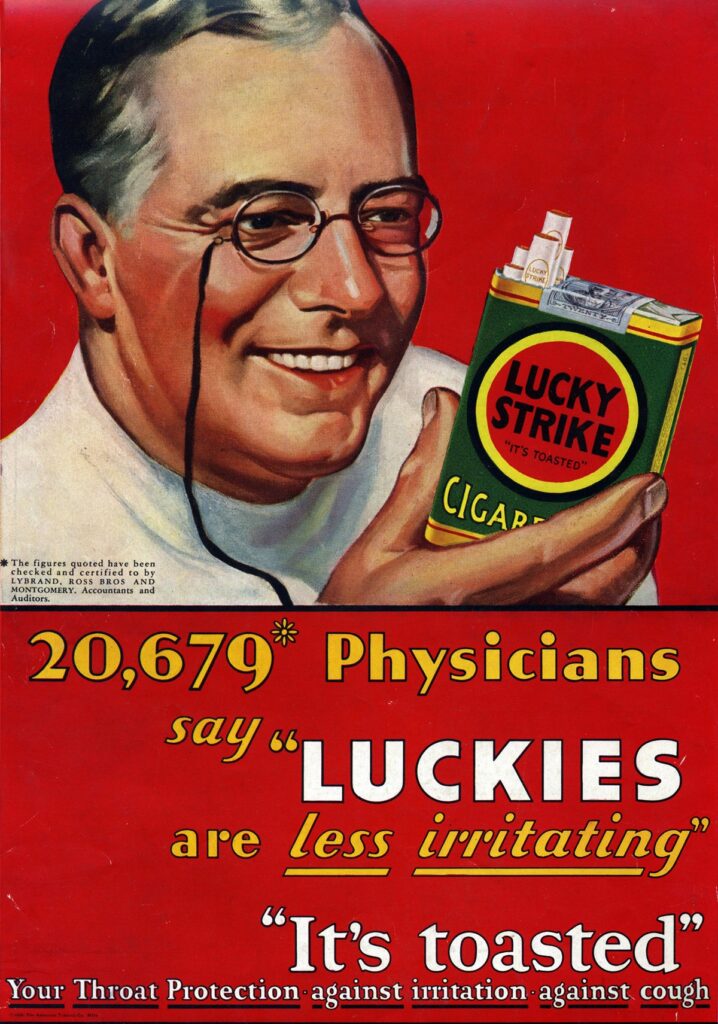
James Bond didn’t find out about the global criminal organization Spectre by surfing on the internet!
There are limits to what casual searching on the web can lead to.
So I don’t know about a worldwide conspiracy. However, I do know about human greed—because it’s public-domain information.
Edward Bernays is a great example.
Nephew of Freud and father of public relations, Bernays used media and group psychology to serve the interests of corporations.
To make companies more profitable, he used physicians or phycologists to influence the masses.
His knowledge of propaganda helped to shape and manipulate public opinion. Not only in the US, but also in Germany. Joseph Goebbels was a fan of his writings.
And today, are we under the spell of propaganda?
It’s a possibility, especially that there’s a lot of money to make from a pandemic.
What’s the point of good propaganda, Mr. Chomsky?
“But you don’t want people to think about that issue. That’s the whole point of good propaganda. You want to create a slogan that nobody’s going to be against, and everybody’s going to be for. Nobody knows what it means, because it doesn’t mean anything. Its crucial value is that it diverts your attention from a question that does mean something: Do you support our policy?”
So a healthy dose of skepticism is always beneficial. As Carl Sagan put it:
“Science is more than a body of knowledge. It is a way of thinking; a way of skeptically interrogating the universe with a fine understanding of human fallibility. If we are not able to ask skeptical questions, to interrogate those who tell us that something is true, to be skeptical of those in authority, then, we are up for grabs for the next charlatan (political or religious) who comes rambling along.”
22-How to Make a Decision with Incomplete Information?

Investors do this all the time. And the best among them think for a while.
Learning how to think is not taught at school. Reading essays like Solitude and Leadership by William Deresiewicz can compensate for that. Here’s an excerpt:
“Thinking means concentrating on one thing long enough to develop an idea about it. Not learning other people’s ideas, or memorizing a body of information, however much those may sometimes be useful. Developing your own ideas. In short, thinking for yourself. You simply cannot do that in bursts of 20 seconds at a time, constantly interrupted by Facebook messages or Twitter tweets, or fiddling with your iPod, or watching something on YouTube.
I find for myself that my first thought is never my best thought. My first thought is always someone else’s; it’s always what I’ve already heard about the subject, always the conventional wisdom. It’s only by concentrating, sticking to the question, being patient, letting all the parts of my mind come into play, that I arrive at an original idea. By giving my brain a chance to make associations, draw connections, take me by surprise.”
In How to Think For Yourself, Paul Graham tells us how to become independent-minded:
“One of the most effective techniques is one practiced unintentionally by most nerds: simply to be less aware what conventional beliefs are. It’s hard to be a conformist if you don’t know what you’re supposed to conform to.”
23-Are We All in This Together?
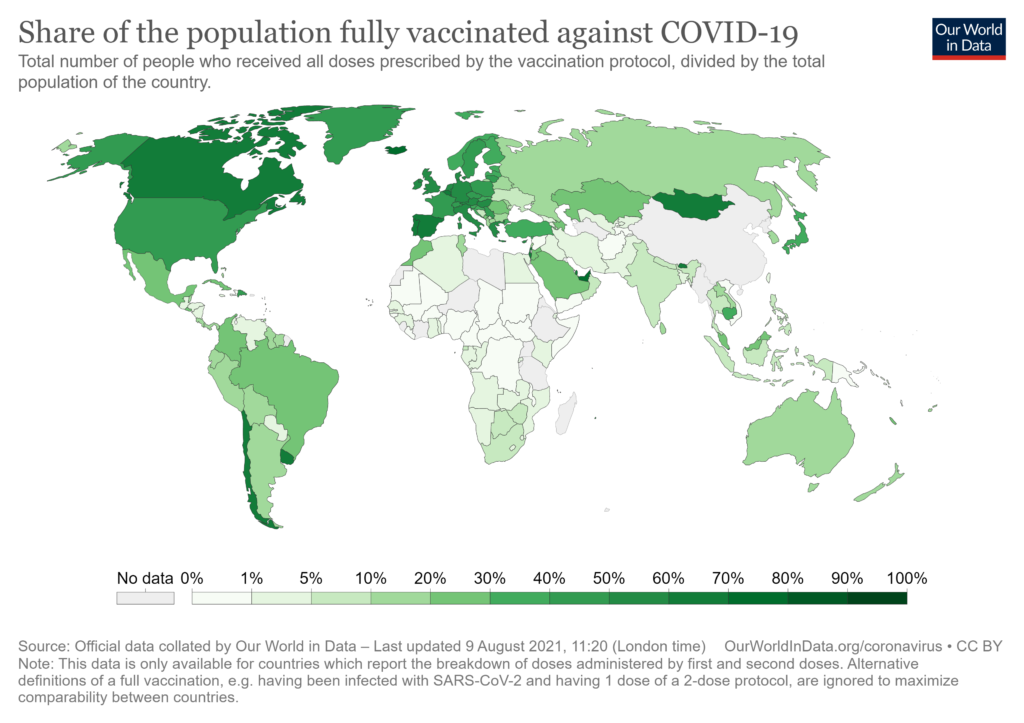
A huge part of the world’s population is in desperate need of vaccines.
The unequal distribution of vaccines has been highlighted in The Washington Post:
“A team at Duke University’s Global Health Innovation Center recently found that high-income countries locked up 53 percent of near-term vaccine supply. They estimate that the world’s poorest 92 countries will not be able to reach a vaccination rate of 60 percent of their populations until 2023 or later.”
There are two important things to notice here:
-High-income countries are only 16 percent of the world’s population.
-We won’t vaccinate the poorest countries in a significant manner until 2023.
It’s in this part of the search that Bill Gates’ name starts coming out.
24-What’s up, Bill?
Most of what I read referred to his interview on Sky News.
Gates is asked if it would be helpful to change intellectual property law to enable “the recipe for these vaccines to be shared.” (2min45)
He answered “No”. And he gave the reason:
“There are only so many vaccine factories in the world, and people are very serious about the safety of vaccines. The thing that’s holding things back in this case isn’t intellectual property. It’s not like there’s some idle vaccine factory with regulatory approval that makes magically safe vaccines. You’ve gotta do the trials on these things. And every manufacturing process has to be looked at in a very careful way.”
Related to this, we find articles about vaccine factories ready to produce the vaccine if only we give them the recipe.
In another article of the Guardian titled Welcome to the New Colonialism, it’s the name of his foundation that comes out.
We learn that the initial plan of Oxford University is “to create an open-source vaccine that could be reproduced by anyone with the capacity to do so”. However, the Bill and Melinda Gates Foundation pressed Oxford to partner with AstraZeneca, “giving it sole rights without any commitment to keep vaccine prices low.”
What’s interesting here is not Bill Gates, it’s the cues about the future.
What is the collective plan to end up the pandemic?
25-Saving Lives or Making Profits?
It seems like the protection of economic interests doesn’t go well with “going back to normal”.
On one hand, we pressure the citizens of rich countries to vaccinate now.
On the other hand, we put no pressure on the few pharma companies to share their knowledge.
Everyone could participate in the production of vaccines and put an end to this pandemic.
In the end, this is what herd immunity means.
We vaccinate a maximum number of people in a short amount of time.
But this is not what’s happening.
Waiting until 2023 increases the chances for the virus to mutate again and again.
If I understand well, viruses don’t choose which Greek alphabet type of virus they’ll become.
They can turn into a weaker virus or a stronger one.
In other words, keeping the production of vaccines the way, it is= gambling with the lives of millions of people.
With a strong variant out there, even the vaccinated people will be in danger.
26-Are You For or Against Vaccines?
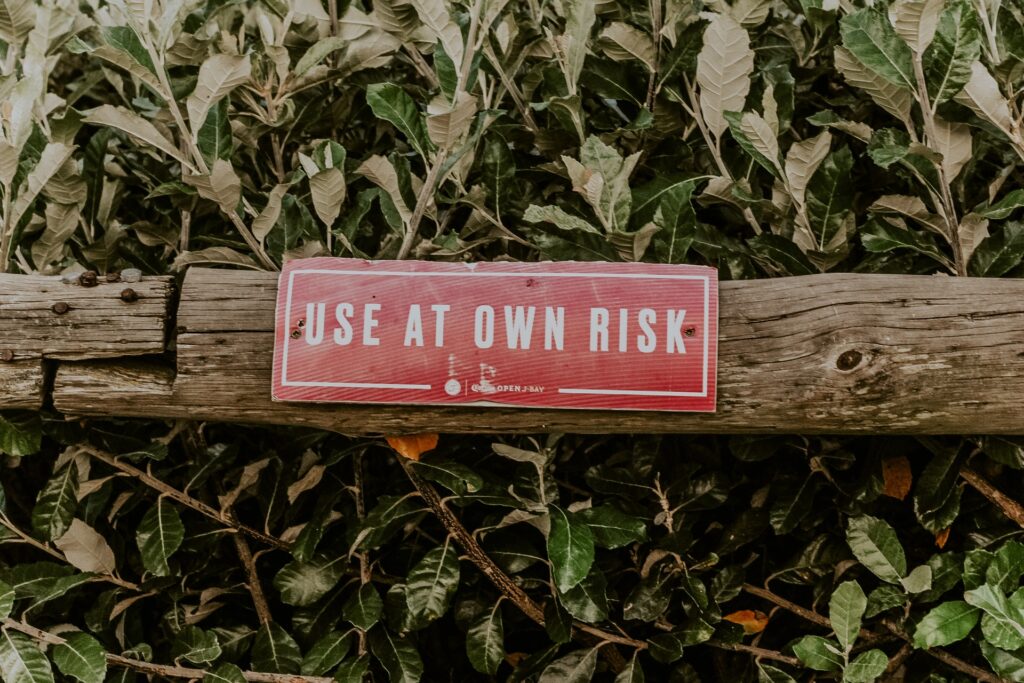
Are you for or against vaccines? That’s not really the question.
A better question would be: What are your concerns?
People’s concerns are legitimate, whether they jump on the vaccines or prefer to wait.
There’s a lack of long-term data on the safety and efficacy of the vaccines.
It might not be a concern for everybody. But for some, it is. And they need to have space to voice their concerns.
There’s also another harm, but this time, it’s in favor of the vaccines.
It’s the financial impact of the pandemic.
This harm doesn’t appear in the numbers. It can affect the healthy and the sick, the young and the old.
People have different concerns. Some require better information; others require better vaccines.
27-Final Thoughts

Now I feel I have more information that I need.
I can go back to my cave and slowly digest.
In the meantime, numbers will keep changing as new studies are showing up.
It took me time to research for this article, to collect information, and compare different sources.
But will it matter next year?
As I’m planning to visit my family in Europe, my considerations will change.
Probably, I’ll make an emotional decision and justify it rationally.
Nietzsche would say in desperation: Human, All Too Human!
Article posted the 13 August 2021
Popular Articles
- Islamic Psychology: A Model Where Faith Has Its Place
- Blindness: From the Invisible Gorilla to the Quranic Perspective
- Muslims’ Unity: A Powerful Solution That Takes Its Time
- The Certainties of Muslims in Uncertain World
- Mongols Invasions: Some Forgotten Lessons to Today’s Muslims
- How to Enjoy Salat and Make it Meaningful
- Are Muslims Meant to Be Sleep Deprived?
- 7 Lessons from Luqman that Will Make You Wise
- How to Make People Change their Mind: Persuasion!
- A Few Thoughts For Muslims
- How to Honor the Prophet?
- Muslims Judging Each Other: Why and How to Be Less Judgy

